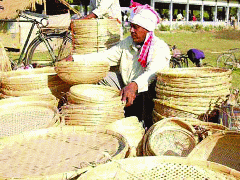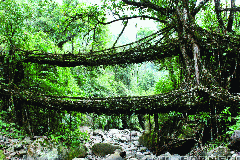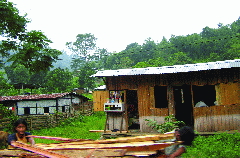Archives
TRANSFORMING THE ECONOMY
The North East is divided into discrete plains regions encompassed within hills, with a number of agro-climatic zones within them. It is characterized by heavy precipitation, extremely rich bio-diversity, fragile hills, high seismicity, and a drainage pattern marked by lateral valleys in the north and transverse valleys in the south, dissected by huge rivers and raging torrents. All of this renders communication difficult and expensive, especially in view of the neglect of the great waterways that were once major arteries of commerce and culture. Partition further isolated an already geo-politically sequestered region. It was left with over 4500 km of external frontier with Bhutan, China, Myanmar and Bangladesh but no more than a slender 22 km connection with the Indian heartland through the tenuous Siliguri corridor, the Gateway to the North East.
The very considerable market disruption, socio-economic distancing and retardation that resulted has not been adequately appreciated or compensated. The North East spreads over a vast expanse of 255,000 sq. Km with a relatively small population of fewer than 40 million today. However, the cultivable area is limited and the land-man ratio has become increasingly adverse. Barring the Imphal Valley and pockets elsewhere, agricultural yields are low while traditional farming with a shrinking jhum cycle has become ecologically unsustainable. Nevertheless, jhum represents a way of life interwoven with collective tribal practices and can be improved. Much land in the hills is owned by the community, not the states, though privatisation and ‘enclosures’ are evident in some places. Urbanisation is generally low, except in Mizoram and Nagaland.
compensated. The North East spreads over a vast expanse of 255,000 sq. Km with a relatively small population of fewer than 40 million today. However, the cultivable area is limited and the land-man ratio has become increasingly adverse. Barring the Imphal Valley and pockets elsewhere, agricultural yields are low while traditional farming with a shrinking jhum cycle has become ecologically unsustainable. Nevertheless, jhum represents a way of life interwoven with collective tribal practices and can be improved. Much land in the hills is owned by the community, not the states, though privatisation and ‘enclosures’ are evident in some places. Urbanisation is generally low, except in Mizoram and Nagaland.
The regional economies are simple, heavily deficit and dependent on the rest of the country for many basic needs. All seven units are special category states whose development plans are almost entirely centrally financed on the basis of 90 per cent grant and 10 per cent loan. The development funding pattern for the special category states accords them built- in preferential treatment. There is no agricultural surplus and limited capital formation and entrepreneurial skills. Assam had seen some development around tea, oil and timber, the region is, however, basically pre-industrial despite a number of saw mills and plywood factories, a few cement plants and other miscellaneous enterprises apart from oil and coal. Handlooms and handicrafts, once the pride of the North East, are on the decline but have a considerable potential if given contemporary functionality through design, marketing and other inputs.
 The region is bountifully endowed with bio-diversity, hydro-potential, oil and gas, coal, limestone and forest wealth. It is ideally suited to produce a whole range of plantation crops, spices, fruit and vegetables, flowers and herbs, much of which could be processed and exported to the rest of the country and worldwide. Markets must be developed and problems of transportation, power, infrastructure, finance and services overcome. Its natural beauty, serenity and rich flora and fauna invite trekking and tourism. The North East tends to be seen as a distant outpost, some kind of land’s end. Yet it was until recently a crossroads and a bridge to South East and East Asia, with its great rivers ending in ocean terminals at Calcutta and Chittagong.
The region is bountifully endowed with bio-diversity, hydro-potential, oil and gas, coal, limestone and forest wealth. It is ideally suited to produce a whole range of plantation crops, spices, fruit and vegetables, flowers and herbs, much of which could be processed and exported to the rest of the country and worldwide. Markets must be developed and problems of transportation, power, infrastructure, finance and services overcome. Its natural beauty, serenity and rich flora and fauna invite trekking and tourism. The North East tends to be seen as a distant outpost, some kind of land’s end. Yet it was until recently a crossroads and a bridge to South East and East Asia, with its great rivers ending in ocean terminals at Calcutta and Chittagong.
The recent MOU with Myanmar restoring border trade and the just concluded ‘Ganga Treaty’ with Bangladesh, however, herald a new chapter. The possible restoration to the North East of its erstwhile transit routes and markets and vice versa suggests new opportunities that can be creatively exploited to mutual benefit. New concepts have begun to excite the international imagination: the South Asia Development Triangle, including eastern and Northeastern India, Nepal, Bhutan and Bangladesh, an extension of this within a larger growth quadrant that takes in Myanmar, Thailand, Laos and Southwest China along the old Burma Road and proposed Trans-Asian Highway and Railway; and a Bay of Bengal Triangle with Calcutta and Chittagong at the apex of a vast hinterland stretching down to Sri Lanka on one side and Singapore on the other.
Even as these ideas are nurtured and exploited, the North East must be enabled to grow at its own pace and in accordance with its own genius. It can not be treated merely as a resource region, market dump and transit yard. There is strong resentment over what is seen as an earlier phase of ‘colonial exploitation’ in which its wealth was extracted for others’ enrichment. Such a path of development is not advocated. On the contrary, the people of the North East must feel that they are equal partners in a process of culturally friendly, equitable and sustainable development. This must be the thrust. Yet delay would be denial. The North East is a latecomer to development. The trauma of partition, political evolution and reorganisation of Assam along the present state boundaries, and continuing internal adjustments to achieve decentralised sub-state structures such as autonomous councils, punctuated with protest movements and insurgencies have interrupted progress.
can not be treated merely as a resource region, market dump and transit yard. There is strong resentment over what is seen as an earlier phase of ‘colonial exploitation’ in which its wealth was extracted for others’ enrichment. Such a path of development is not advocated. On the contrary, the people of the North East must feel that they are equal partners in a process of culturally friendly, equitable and sustainable development. This must be the thrust. Yet delay would be denial. The North East is a latecomer to development. The trauma of partition, political evolution and reorganisation of Assam along the present state boundaries, and continuing internal adjustments to achieve decentralised sub-state structures such as autonomous councils, punctuated with protest movements and insurgencies have interrupted progress.
The building of new political institutions, with former districts graduating to statehood, has necessarily been a slow process. Traditional institutions were in some cases too soon or somewhat carelessly by-passed for newer structures that are perhaps not always well-suited to the region. Likewise, all-India norms and patterns of administration and planning have been extended to or have sometimes been sought by these units only to prove an embarrassment.
These are not insuperable problems; but they need to be addressed. This can be done by changing from planning for the North East to planning with the North East for the benefit of the individual units, the region and the country as a whole.
The North East has vast potential resources but little or no ‘plan’ resources today. It is heavily indebted in spite of high per capita plan outlays and subventions. Huge establishment costs exceed state revenue
collections as government service provides the sole and certainly the principal avenue of employment. This situation can not be abruptly ended without creating viable alternatives.
The paradox is that there is an enormous amount of work to be done but few jobs. Imaginative solutions must be found. Likewise, there have been grievous leakages, partly to underground extortion and ‘taxation’ but also as a result of the breakdown of traditional values and institutions, the bewilderingly rapid changeover from barter to a monetised economy, and the rise of new elites.
Many of the Northeastern states joined the planning process later than most others. Mizoram did so only in the Seventh Plan while Nagaland has been insurgency-prone since the 1950s. It is often asserted that the Northeastern states were created for good and sound political reasons and not on the basis of economic viability.
It would perhaps help understanding to place the development of the Northeastern states in several concentric circles: first the local community; next the autonomous councils/states; third, the Northeastern region, in view of the interdependence of the several constituent entities and the overriding reality of a common gateway to the heartland; beyond that the bigger ‘Ganga- Brahmaputra-Meghna’ (GBM) resource region; and, finally, the larger world of South East Asia and South West China; the North East is indeed India’s cultural and economic bridgehead to these fast growing economies.
There are four deficits that confront the North East, a basic needs deficit; an infrastructural deficit; a resource deficit, and, most important, a two-way deficit of understanding with the rest of the country which compounds the others.
The North East has so far depended exclusively on the Centre for development funding. A more rapid pace of the growth would generate larger internal resources. This could perhaps be enlarged through the addition of private investment, Indian and foreign, within a well-defined framework.
In terms of per capita state domestic product or other standard development indices such as power, road length or hospital beds, the North East ranks well below the national average. Only in literacy does it stand high. Yet this too can be misleading as vocational training, entrepreneurial skills and the basic grounding in mathematics and science is weak. The school infrastructure is inadequate, including that of trained teachers. Imphal has 28 Intermediate colleges which, in the absence of matching employment opportunities, are adding to problems of educated unemployment, frustration, drugs and insurgency. The right overall balance and linkages are missing.
For the same reason, it would be a pity for the North East to sprout more and more run of the mill universities, Central or State. What is needed is for the concerned vice-chancellors and the UGC to get together and plan to develop within each of them strong area studies and a few centre of excellence in disciplines and languages relevant to the region.
New patterns of development need to be structured. There are examples of innovation: Nagaland Village Development Boards with their common fund and the Nagaland Environment Protection and Economic Development (NEPED) programme for introducing upgraded tree farming into the jhum cycle as a starting point for tapping its considerable bio-diversity, Meghalaya’s groping towards a new concept of ‘tribal interest’ for acquiring land, as well as its Economic Development Council and plans for reorganising its electricity board; Mizoram’s new land use policy; Tripura’s smallholder rubber plantations, and Assam’s experiments with apex councils and proposals for reinvestment of agricultural income tax by assesses for approved purposes. Each State could learn from the others’ experience.
One can envisage other models such as the establishment of special economic zones and EPZs to take advantage of the emerging opportunities of trade with Bangladesh and Myanmar; counter-guarantees to attract investment into the region, the establishment of upper-catchment area authorities in relation to the large dams under consideration; and the application of a special income tax regime for the hitherto exempted tribal areas of the North East.
It might also be worth exploring the idea of freezing the disputed areas along Assam’s borders with Meghalaya, Arunachal Pradesh, Nagaland and Mizoram for, say, 25 years and developing them with Central assistance into infrastructural and industrial hubs for hills-plains interchange. These could provide sites for airfields, railheads, warehousing, cold storages, market yards, regional institutions, medium/large industry, processing units, and R&R centres for persons displaced by dams and development in the hills.
It is observed that the North Eastern region of India has often been visualized as the remote landlocked underdeveloped region of a dynamic economy on the march. The difference between the potential and actual economic performance is most overwhelming for the region which has large international borders with several neighbours like Bangladesh, Bhutan, China and Myanmar and is close to Nepal and Indo-China. It has the potential to serve as the opening for the entire Indian vicinity. So far the actuality is immensely substandard. Therefore, evaluating the problem and prospect of the North Eastern region for trade and economic exchanges with the neighbouring countries assumes immense importance in the study of the economic development of the region.
Dr. Parag Kr. Deka
Pranab Baishya

